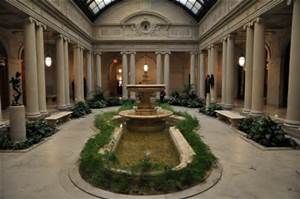Feb 13 2017 - May 14 2017
New York City, NY
Joseph Mallord William Turner (1775–1851), Britain’s greatest land and seascape artist of the nineteenth century, took on the theme of the port throughout his career both in monumental oil paintings and in watercolors. An insatiable traveler and an artist with a deep fascination with light, topography, and local traditions, as well as with classical antiquity, Turner brought an innovative approach to modern ports and imagined harbors set in ancient times. Turner’s Modern and Ancient Ports: Passages through Time, is a major exhibition that brings together some thirty-five works by the artist from the 1810s to the late 1830s in oil, watercolor, and graphite, presenting contemporary views of cities in England, France, and Germany, as well as images of classical ports.
The springboard for this show is a pair of monumental paintings by Turner in The Frick Collection — the Harbor of Dieppe of 1825 and Cologne, The Arrival of a Packet-Boat: Evening of 1826 -- which are widely recognized as significant turning points in the artist’s career. A focused examination of these works is long overdue and provides an ideal occasion to consider afresh one of the central motifs of Turner’s art. This exhibition will also unite for the first time Dieppe and Cologne with a closely related, yet unfinished, work from Tate Britain that depicts the modern harbor of Brest. As supported by recent technical analysis, The Harbor of Brest was likely intended to form a series of monumental European ports with the two Frick paintings. This trio of canvases — all made at a time when Turner was experimenting with the representation of light — offers a fascinating glimpse into his technique as well as the everyday life of major European ports of distinctly different regions. Displayed alongside these paintings will be two sketchbooks filled with drawings made on site by Turner during his travels to the Continent, the material from which he later developed his canvases.
The exhibition also features three oil paintings from the later 1820s and 1830s in which Turner evokes ancient Rome and Carthage. These share with the artist’s modern ports their compositional format — a central expanse of water, with land on either side, beneath a luminous sky — and their array of quotidian detail — the same variety of mundane objects and figures at work and at leisure that appear in the Harbor of Dieppe and Cologne — now evoking the daily life of a long bygone era. Into these light-filled and richly detailed scenes, Turner integrates his narrative content — momentous scenes of arrival and departure that look forward and back. The close relationship of Turner’s modern and ancient ports reveals the extent to which observation and imagination overlap in his process.
Central to the exhibition are a selection of some two-dozen of Turner’s watercolors from these same years, often made for series of prints for a bourgeoning class of leisure travelers in the post-Napoleonic era. Representing port towns and cities along the various waterways of the British Isles and Continental Europe, these dazzling small-scale works share with the grand harbors of the 1820s their picturesque subject matter and formal qualities of composition and color. The breathtaking effects of light and color that Turner achieved in watercolor, in fact, informed his work on canvas, resulting in a freer approach to his use of materials and painting technique, as seen in the Frick pictures and in the ancient scenes.
Credit: Exhibition overview from museum website
Whether you go or not, the exhibition catalog , Turner’s Modern and Ancient Ports: Passages through Time, is an in-depth study of these two seminal paintings and also addresses a wide selection of Turner’s works in both oil and watercolor from the 1820s, placing them in the context of radical changes in British social and economic structures taking place at the time. Drawing from period travel accounts, contemporary critical commentary, and new technical analyses of Turner’s work, this magnificently illustrated book brings a fresh, new perspective to the pivotal middle years of Turner’s career.
Widely considered Britain’s greatest painter, Joseph Mallord William Turner (1775–1851) is best known for his light-filled landscapes and seascapes. A relentless traveler, Turner often turned his artistic attention to the theme of modern and ancient ports. In the mid-1820s, Turner exhibited two monumental, and controversial, paintings of ports: Cologne and Dieppe. Shocking for their intense luminosity and yellow tonality, as well as for Turner’s unorthodox handling of paint, these works marked a transition in the artist’s career as he moved away from naturalism and toward a new, poetic topography.

